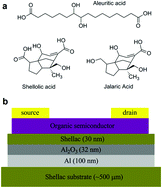Biocompatible and sustainable electronic-grade materials are integral for the development of electronics for biointegration and ‘use-and-throw’ applications. Herein we report the use of the natural resin shellac in organic field-effect transistors. Shellac was employed to cast robust and smooth substrates suitable for durable transistor devices. In addition shellac displays excellent insulating properties enabling its use as a high-quality dielectric layer for organic field-effect transistor (OFET) devices. We demonstrate that two common organic semiconductors,
